A Companion to Classical Electrodynamics
3rd Edition by J.D. Jackson
Rudolph J. Magyar
February 5, 2002
cRudolph J. Magyar. No portion of this may be reproduced for profit
without the expressed prior written consent of Rudolph J. Magyar.
1
�
A lot of things can be said about Classical Electrodynamics, the third
edition, by David J. Jackson. It’s seemingly exhaustive, well researched, and
certainly popular. Then, there is a general consensus among teachers that
this book is the definitive graduate text on the subject. In my opinion, this
is quite unfortunate. The text often assumes familiarity with the material,
skips vital steps, and provides too few examples.
It is simply not a good
introductory text. On the other hand, Jackson was very ambitious. Aside
from some notable omissions (such as conformal mapping methods), Jackson
exposes the reader to most of classical electro-magnetic theory. Even Thomas
Aquinas would be impressed! As a reference, Jackson’s book is great!
It is obvious that Jackson knows his stuff, and in no place is this more
apparent than in the problems which he asks at the end of each chapter.
Sometimes the problems are quite simple or routine, other times difficult, and
quite often there will be undaunting amounts of algebra required. Solving
these problems is a time consuming endevour for even the quickest reckoners
among us. I present this Companion to Jackson as a motivation to other
students. These problems can be done! And it doesn’t take Feynmann to do
them.
Hopefully, with the help of this guide, lots of paper, and your own wits;
you’ll be able to wrestle with the concepts that challenged the greatest minds
of the last millenium.
solving these problems.
Before I begin, I will recommend several things which I found useful in
• Buy Griffiths’ text, an Introduction to Electrodynamics. It’s well writ-
ten and introduces the basic concepts well. This text is at a more basic
level than Jackson, and to be best prepared, you’ll have to find other
texts at Jackson’s level. But remember Rome wasn’t build in a day,
and you have to start somewhere.
• Obtain other texts on the level (or near to it) of Jackson.
I rec-
ommend Vanderlinde’s Electromagnetism book or Eyges’ Electromag-
netism book. Both provide helpful insights into what Jackson is talking
about. But even more usefully, different authors like to borrow each
others’ problems and examples. A problem in Jackson’s text might
be an example in one of these other texts. Or the problem might be
rephrased in the other text; the rephrased versions often provide insight
into what Jackson’s asking! After all half the skill in writing a hard
i
�
physics problem is wording the problem vaguely enough so that no one
can figure out what your talking about.
• First try to solve the problem without even reading the text. More
often than not, you can solve the problem with just algebra or only a
superficial knowledge of the topic. It’s unfortunate, but a great deal of
physics problems tend to be just turning the crank. Do remember to
go back and actually read the text though. Solving physics problems
is meaningless if you don’t try to understand the basic science about
what is going on.
• If you are allowed, compare your results and methods with other stu-
dents. This is helpful. People are quick to tear apart weak arguments
and thereby help you strengthen your own understanding of the physics.
Also, if you are like me, you are a king of stupid algebraic mistakes. If
ten people have one result, and you have another, there’s a good like-
lihood that you made an algebraic mistake. Find it. If it’s not there,
try to find what the other people could have done wrong. Maybe, you
are both correct!
• Check journal citations. When Jackson cites a journal, find the refer-
ence, and read it. Sometimes, the problem is solved in the reference,
but always, the references provide vital insight into the science behind
the equations.
A note about units, notation, and diction is in order. I prefer SI units
and will use these units whenever possible. However, in some cases, the use
of Jacksonian units is inevitable, and I will switch without warning, but of
course, I plan to maintain consistency within any particular problem. I will
set c = 1 and ¯h = 1 when it makes life easier; hopefully, I will inform the
reader when this happens. I have tried, but failed, to be regular with my
symbols. In each case, the meaning of various letters should be obvious, or
else if I remember, I will define new symbols. I try to avoid the clumsy d3x
symbols for volume elements and the d2x symbols for area elements; instead,
I use dV and dA. Also, I will use ˆx,ˆy, and ˆz instead of ˆi,ˆj, and ˆk. The only
times I will use ijk’s will be for indices.
Please, feel free to contact me, rmagyar@eden.rutgers.edu, about any
typos or egregious errors. I’m sure there are quite a few.
ii
�
Now, the fun begins...
iii
�
Problem 1.1
Use Gauss’ theorem to prove the following:
a. Any excess charge placed on a conductor must lie entirely on
its surface.
In Jackson’s own words, “A conductor by definition contains charges capable
of moving freely under the action of applied electric fields”. That implies
that in the presence of electric fields, the charges in the conductor will be
accelerated. In a steady configuration, we should expect the charges not to
accelerate. For the charges to be non-accelerating, the electric field must
vanish everywhere inside the conductor, E = 0. When E = 0 everywhere
inside the conductor 1, the divergence of E must vanish. By Gauss’s law,
we see that this also implies that the charge density inside the conductor
vanishes: 0 = ∇ · E = ρ
�0 .
b. A closed, hollow conductor shields its interior from fields due
to charges outside, but does not shield its exterior from the fields
due to charges placed inside it.
The charge density within the conductor is zero, but the charges must be
located somewhere! The only other place in on the surfaces. We use Gauss’s
law in its integral form to find the field outside the conductor.
qi
E · d A =
1
�0
Where the sum is over all enclosed charges. Evidently, the field outside the
conductor depends on the surface charges and also those charges concealed
deep within the cavities of the conductor.
c. The electric field at the surface of a conductor is normal to the
surface and has a magnitude σ
�0 , where σ is the charge density per
unit area on the surface.
We assume that the surface charge is static. Then, E at the surface of a con-
ductor must be normal to the surface; otherwise, the tangential components
of the E-field would cause charges to flow on the surface, and that would
contradict the static condition we already assumed. Consider a small area.
∇ · EdV =
E · d A =
ρ
�0
dV
1excluding of course charge contained within any cavities
1
�
But ρ = 0 everywhere except on the surface so ρ should more appropriately
be written σδ(f (x)). Where the function f (x) subtends the surface in ques-
tion. The last integral can then be written
rearranged.
�0 ˆn · d A. Our equation can be
σ
E · d A =
ˆn · d A →
σ
�0
E − σ
�0
ˆn
· d A = 0
And we conclude
E =
σ
�0
ˆn
2
�
In spherical coordinates, a charge Q distributed over spherical shell of
Problem 1.3
Using Dirac delta functions in the appropriate coordinates, express
the following charge distributions as three-dimensional charge den-
sities ρ(x).
a.
radius, R.
The charge density is zero except on a thin shell when r equals R. The charge
density will be of the form, ρ ∝ δ(r − R). The delta function insures that
the charge density vanishes everywhere except when r = R, the radius of the
sphere. Integrating ρ over that shell, we should get Q for the total charge.
Aδ(r − R)dV = Q
A is some constant yet to be determined. Evaluate the integral and solve for
A.
Aδ(r − R)dV =
Aδ(r − R)r2d(cos θ)dφdr = 4πR2A = Q
So A = Q
4πR2 , and
ρ(r) =
Q
4πR2 δ(r − R)
b. In cylindrical coordinates, a charge λ per unit length uniformly distributed
over a cylindrical surface of radius b.
Aδ(r − b)dA = λ
Since we are concerned with only the charge density per unit length in the
axial direction, the integral is only over the plane perpendicular to the axis
of the cylinder. Evaluate the integral and solve for A.
Bδ(r − b)dA =
Bδ(r − b)rdθdr = 2πbB = λ
So B = λ
2πb, and
ρ(r) =
δ(r − b)
λ
2πb
c. In cylindrical coordinates, a charge, Q, spread uniformly over a flat circular
disc of negligible thickness and radius, R.
AΘ(r − R)δ(z)dV = Q
3
�
The Θ function of x vanishes when x is negative; when x is positive, Θ is
unity.
AΘ(R − r)δ(z)dV =
AΘ(R − r)δ(z)rdθdzdr = πR2A = Q
So A = Q
πR2 , and
ρ(r) =
d. The same as in part c, but using spherical coordinates.
Q
πR2 Θ(R − r)δ(z)
θ − π
2
dV = Q
AΘ(R − r)δ
Evaluate the integral and solve for A.
AΘ(R − r)δ
θ − π
2
dV =
AΘ(R − r)δ
θ − π
2
r2d(cos θ)dφdr
= 2πR2A = Q
So A = Q
2πR2 , and
ρ(r) =
Q
2πR2 Θ(R − r)δ
θ − π
2
4
�
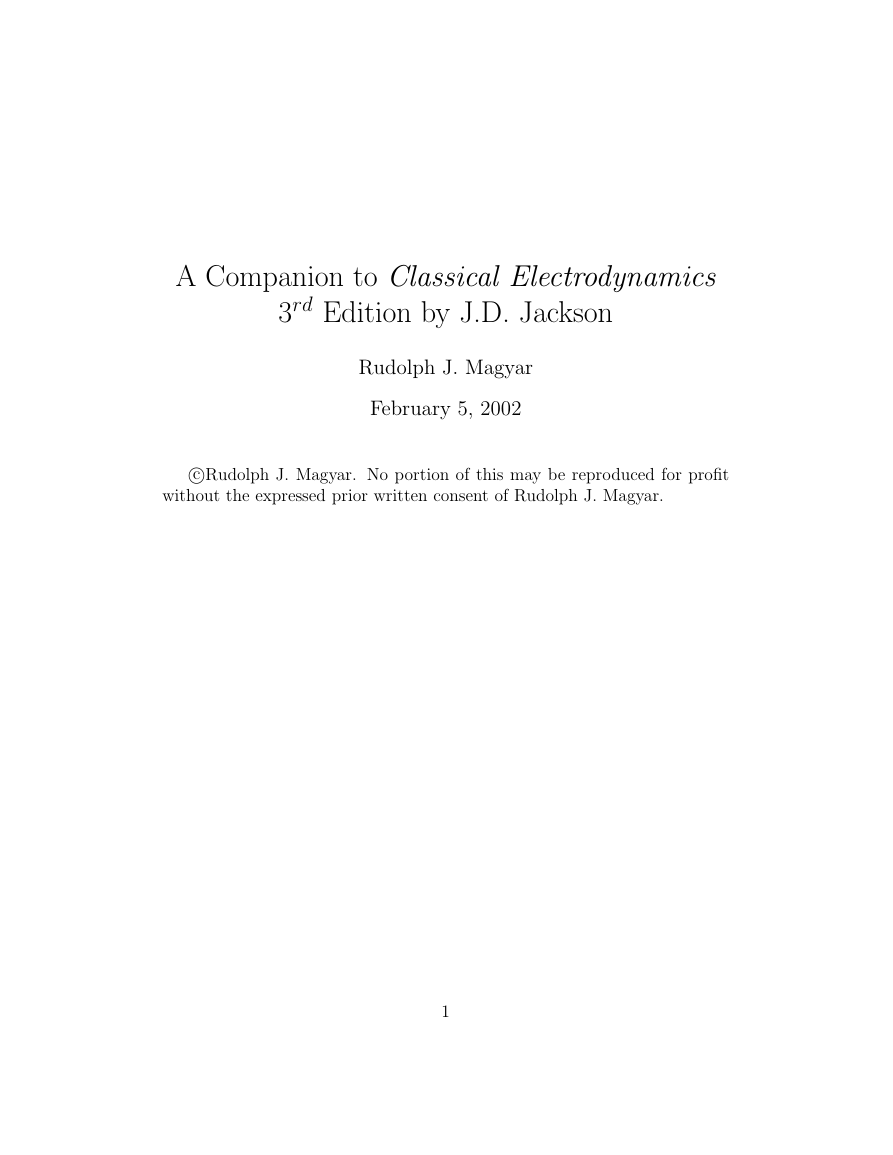
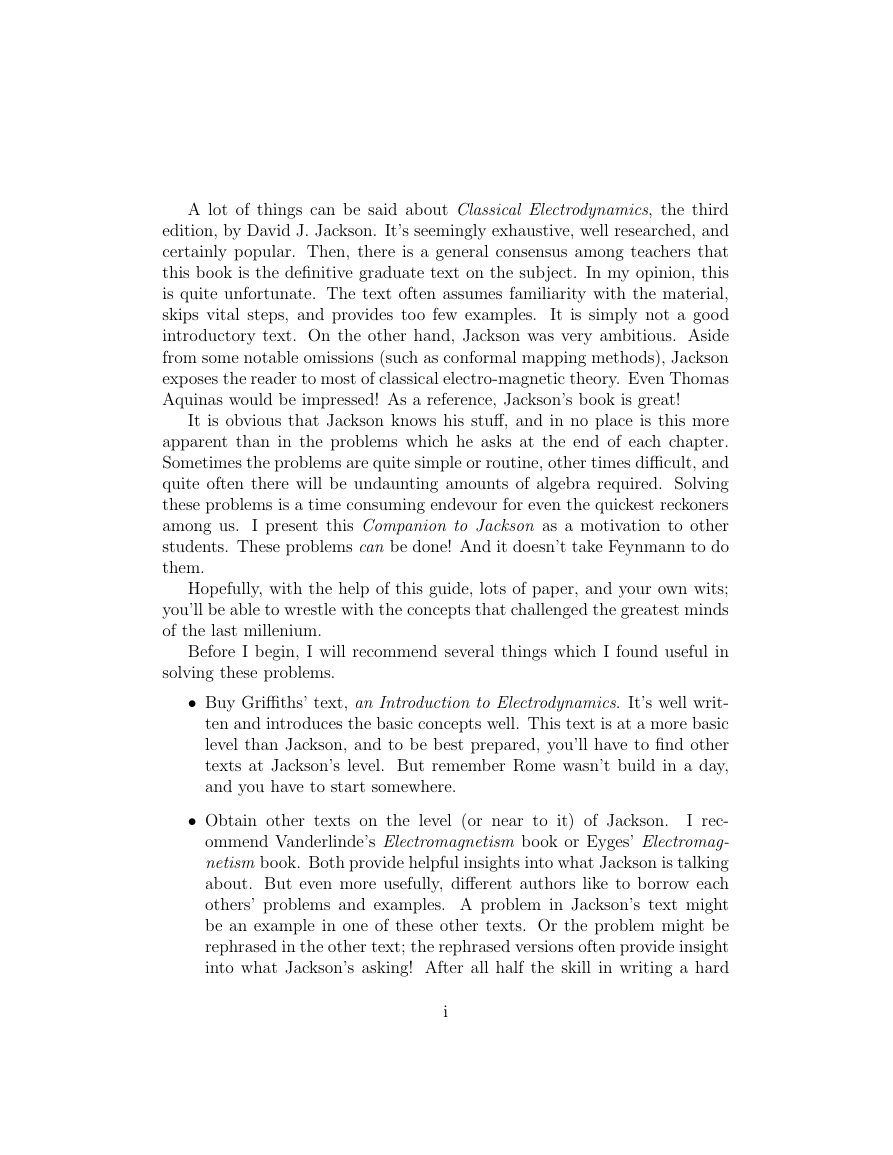
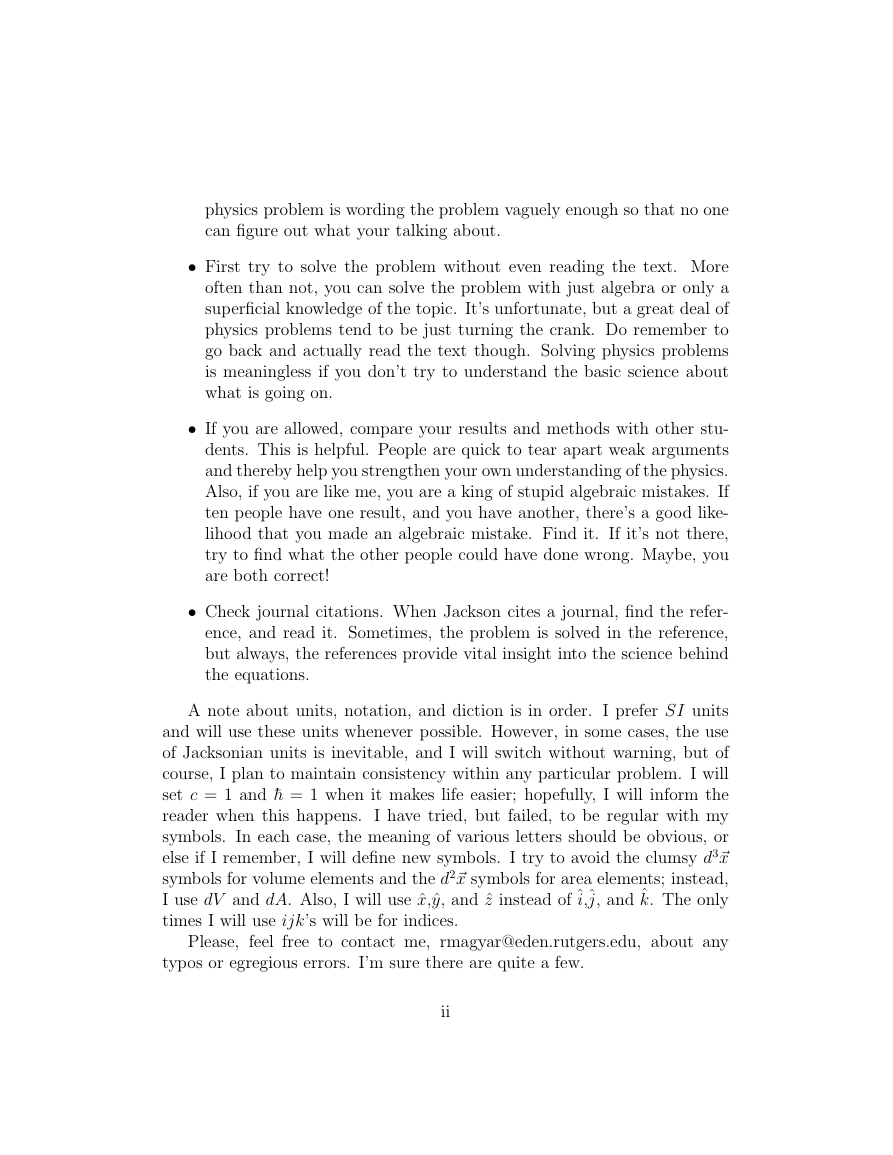


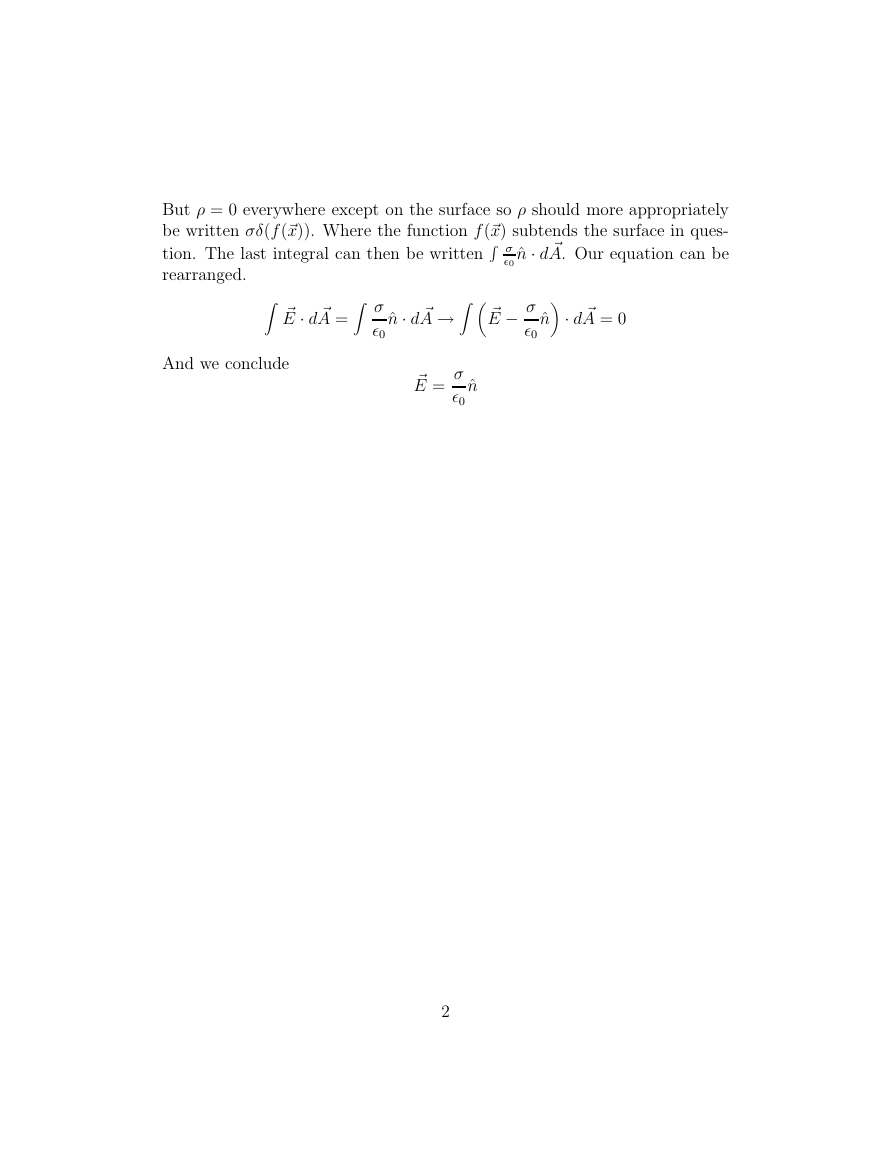
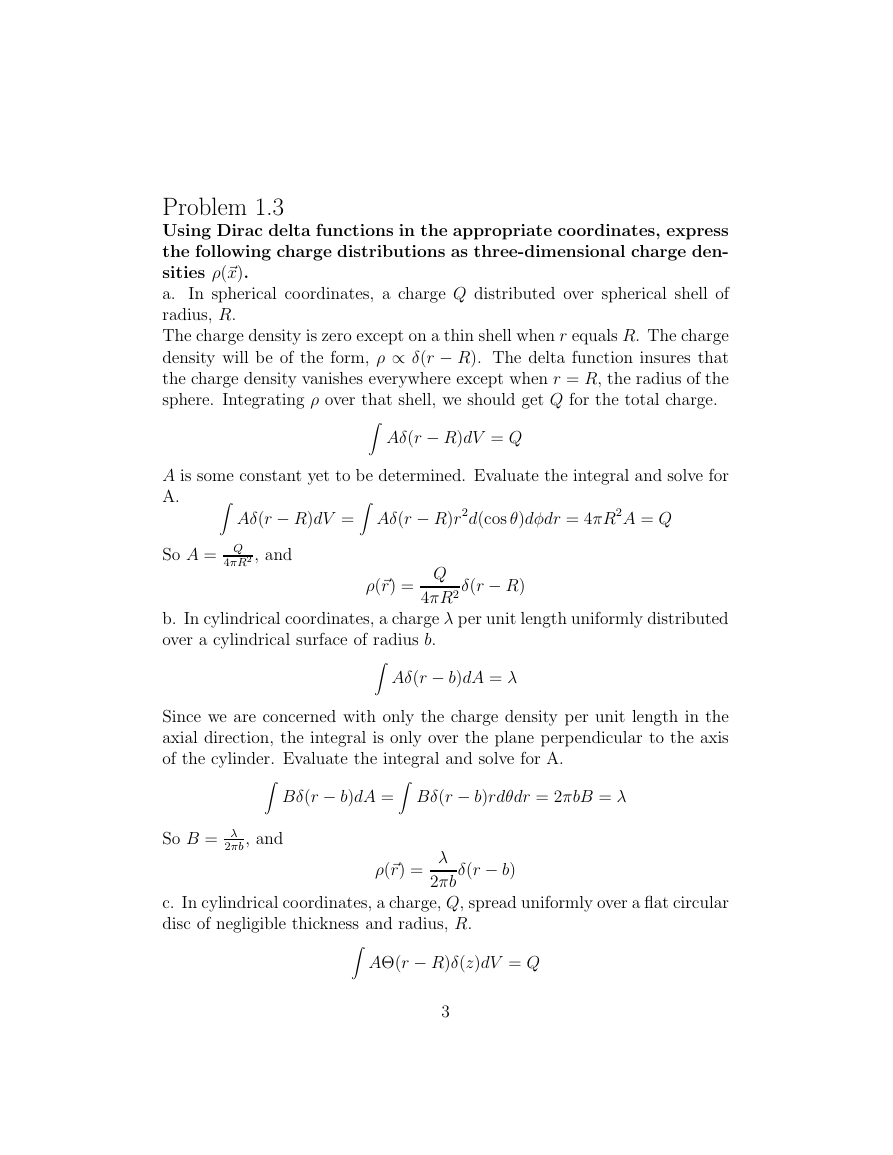
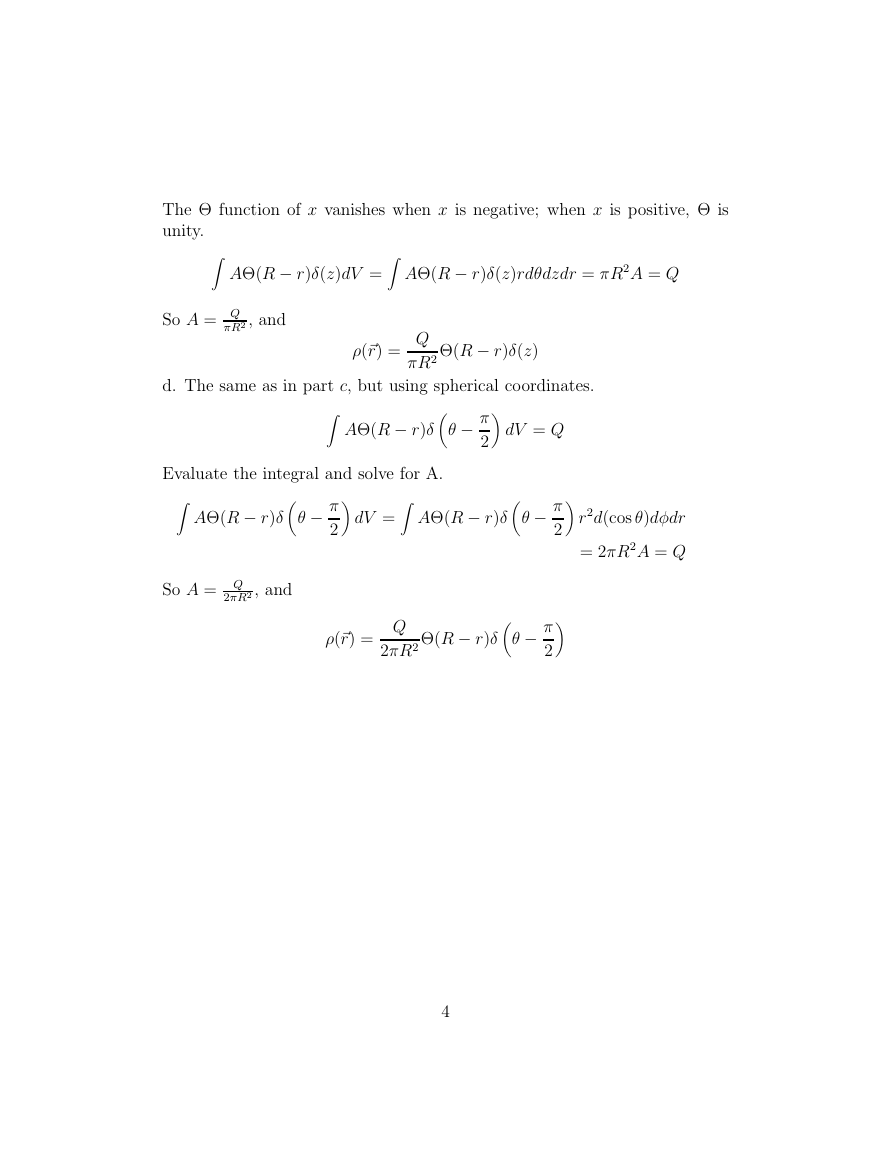








 2023年江西萍乡中考道德与法治真题及答案.doc
2023年江西萍乡中考道德与法治真题及答案.doc 2012年重庆南川中考生物真题及答案.doc
2012年重庆南川中考生物真题及答案.doc 2013年江西师范大学地理学综合及文艺理论基础考研真题.doc
2013年江西师范大学地理学综合及文艺理论基础考研真题.doc 2020年四川甘孜小升初语文真题及答案I卷.doc
2020年四川甘孜小升初语文真题及答案I卷.doc 2020年注册岩土工程师专业基础考试真题及答案.doc
2020年注册岩土工程师专业基础考试真题及答案.doc 2023-2024学年福建省厦门市九年级上学期数学月考试题及答案.doc
2023-2024学年福建省厦门市九年级上学期数学月考试题及答案.doc 2021-2022学年辽宁省沈阳市大东区九年级上学期语文期末试题及答案.doc
2021-2022学年辽宁省沈阳市大东区九年级上学期语文期末试题及答案.doc 2022-2023学年北京东城区初三第一学期物理期末试卷及答案.doc
2022-2023学年北京东城区初三第一学期物理期末试卷及答案.doc 2018上半年江西教师资格初中地理学科知识与教学能力真题及答案.doc
2018上半年江西教师资格初中地理学科知识与教学能力真题及答案.doc 2012年河北国家公务员申论考试真题及答案-省级.doc
2012年河北国家公务员申论考试真题及答案-省级.doc 2020-2021学年江苏省扬州市江都区邵樊片九年级上学期数学第一次质量检测试题及答案.doc
2020-2021学年江苏省扬州市江都区邵樊片九年级上学期数学第一次质量检测试题及答案.doc 2022下半年黑龙江教师资格证中学综合素质真题及答案.doc
2022下半年黑龙江教师资格证中学综合素质真题及答案.doc